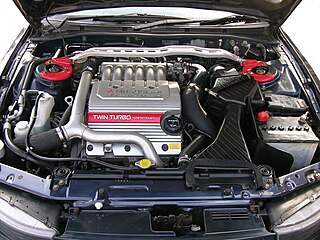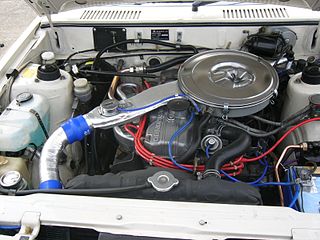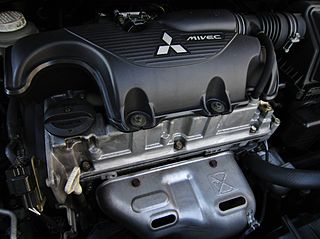
The Willys F4-134 Hurricane was an inline-4 F-head piston engine that powered the M38A1 military Jeep in 1952, followed by the famous Jeep CJ in the CJ-3B, CJ-5, and CJ-6 models. It was also used in the Willys 473 and 475 pickups, wagons, and sedan deliveries. It replaced the Willys Go Devil engine that was used in the MB Jeep and other early Jeep-based models like the Jeepster. This engine was also built by Mitsubishi for their license-built Jeep, as well as other applications.

The GA engine is a 1.3 to 1.6 L inline-four piston engine from Nissan. It has a cast-iron block and an aluminum head. There are SOHC and DOHC versions, 8, 12, and 16 valve versions, carbureted, single-point, and multi-point injected versions, and versions with variable valve timing (GA16DE). The GA was produced from August 1987 through 2013. Since 1998, it was only available from Mexico in the B13.

The Mitsubishi 6A1 engine is a series of piston V6 engines from Mitsubishi Motors, found in their small and medium vehicles through the 1990s. They ranged from 1.6 to 2.5 L in size, and came with a variety of induction methods and cylinder head designs and configurations.

The Mitsubishi Astron or 4G5/4D5 engine, is a series of straight-four internal combustion engines first built by Mitsubishi Motors in 1972. Engine displacement ranged from 1.8 to 2.6 litres, making it one of the largest four-cylinder engines of its time.

The Mitsubishi Sirius or 4G6/4D6 engine is the name of one of Mitsubishi Motors' four series of inline-four automobile engines, along with Astron, Orion, and Saturn.

The Mitsubishi Orion or 4G1 engine is a series of inline-four internal combustion engines introduced by Mitsubishi Motors in around 1977, along with the Astron, Sirius, and Saturn. It was first introduced in the Colt and Colt-derived models in 1978. Displacement ranges from 1.2 to 1.6 L.

The Mitsubishi 4G9 engine is a series of straight-4 automobile engines produced by Mitsubishi Motors. All are 16-valve, and use both single- and double- overhead camshaft heads. Some feature MIVEC variable valve timing, and it was the first modern gasoline direct injection engine upon its introduction in August 1996.

The 6G7 series or Cyclone V6 engine is a series of V6 piston engines from Mitsubishi Motors. Five displacement variants were produced from 1986 to 2021, with both SOHC and DOHC, naturally aspirated and turbo charged layouts. While MIVEC variable valve timing has also been implemented in some versions the 2.5, 3.0, and 3.5 L versions were also available with gasoline direct injection. This engine has been the flagship powerplant of the company except when they briefly built a V8 in 1999–2001. The staple of their high-end sedans, it was given twin-turbos for the Mitsubishi GTO, and became the most powerful car ever built by the company at the time.

The Toyota JZ engine family is a series of inline-6 automobile engines produced by Toyota Motor Corporation. As a replacement for the M-series inline-6 engines, the JZ engines were 24-valve DOHC engines in 2.5- and 3.0-litre versions.
The Honda B20A engine series, known as the B20A and B21A, was an inline four-cylinder engine family from Honda introduced in 1985 in the second-generation Honda Prelude. Also available in the contemporary third-generation Honda Accord in the Japanese domestic market, along with the Accord-derived Vigor, the B20A was Honda's second line of multivalve DOHC inline four-cylinder engines behind the "ZC" twin-cam variant of the ordinarily SOHC D-series, focused towards performance and displacing 2.0 to 2.1 litres.

The Hyundai Theta is a gasoline four-cylinder automobile engine family. The third all-aluminum engine of Hyundai Motor Company debuted in the fourth-generation Hyundai Sonata sedan, which was unveiled in August 2004 in South Korea. Hyundai Motor Manufacturing Alabama (HMMA) built a Theta II engine shop on the grounds of their Montgomery, Alabama automobile factory.

The Mitsubishi 3G8 engine is a range of three-cylinder powerplant from Mitsubishi Motors, introduced in the fifth generation of their Mitsubishi Minica kei car. In common with other contemporary engines in the class, it could be specified with many advanced technologies despite its diminutive size, including multi-valve cylinder heads and double overhead camshafts. The top-of-the-line Dangan ZZ variant was also the first kei car to benefit from turbocharging. In 1987 Mitsubishi was the first manufacturer to supercharge a kei vehicle, and in 1989 became the world's first production car to feature five valves per cylinder, ahead of similar developments by Bugatti, Audi, Ferrari and Toyota.

The Mitsubishi 4A3 engine is a range of alloy-headed inline four-cylinder engines from Mitsubishi Motors, introduced in 1993 in the sixth generation of their Mitsubishi Minica kei car. It shares a 72 mm (2.8 in) bore pitch with the 3G8-series three-cylinder engines, but has a considerably shorter stroke so as to stay beneath the 660 cc limit imposed by the Kei class.

The Mitsubishi 6B3 engine is a range of all-alloy piston V6 engines developed by Mitsubishi Motors. Currently, only one engine has been developed, a 3.0 L (2,998 cc) V6 first introduced in the North American version of the second generation Mitsubishi Outlander which debuted in October 2006.
The Toyota B engine family was a series of inline-four diesel engines.
The Nissan ZD30 engine family is a 3.0-litre inline-four cylinder diesel engine with a bore and stroke of 96 mm × 102 mm, that replaced the Nissan QD, BD and TD engines. At Renault it also replaced the Sofim 8140 engine and is the only truck diesel engine which remained with Nissan Motors when they sold Nissan Diesel to Volvo trucks in 2007.

The Suzuki M engine family is a line of automobile engines from Suzuki. Ranging in displacement from 1.3 L to 1.8 L, it is a modern engine line with dual overhead cams, 16 valves, and multi-point fuel injection (MPFI). Fully developed in-house following Suzuki's separation from General Motors, the M engine replaced the long-lived G engine family.

The EA827 family of petrol engines was initially developed by Audi under Ludwig Kraus leadership and introduced in 1972 by the B1-series Audi 80, and went on to power many Volkswagen Group models. This is a very robust water-cooled engine configuration for four- up to eight- cylinders. In Brazil this engine was produced under the name Volkswagen AP AP.














